The environmental impact of all types of manufacturing is under scrutiny, and dairy processors are targeting innovative approaches to incorporating renewable energy into their businesses.
This often involves a full analysis of all operations to pinpoint inefficiencies in addition to exploring alternative energy sources to ensure plants will have access to continuously reliable energy in the future.
Farm-to-plant connection
George Crave, founder and president of Waterloo, Wis.-based Crave Brothers Farmstead Cheese, said his company’s energy efficiency initiatives start on the farm, beginning with the modern genetics of its Holsteins that result in improved per cow milk production.
The company also has two anaerobic digesters that can each process 750,000 gallons of waste from the farm and factory. The digesters run continuously and convert the methane into enough electricity to power the farm, cheese factory and 300 homes in the surrounding community. The liquid byproducts from the process are used as fertilizer on the field, and the solid byproducts are used as animal bedding.
Having a processing plant located alongside a farm has resulted in further efficiencies, as Crave Brothers pipelines its milk underground, thus eliminating the need for trucks. Water recycling and conservation efforts also are a priority for the company.
Crave said it is important for the industry to communicate such efforts to consumers to help them understand what’s really going on behind the scenes in dairy processing.
“Without the consumer buying in to and appreciating our story all the way back to the farms and field, we are leaving too much for their discretion to find fault or criticize,” Crave said.
He also said in the future more efficient boilers will be another method of improving efficiency.
Evaluating energy use
Rumiano Cheese Company’s facility in Crescent City, Calif., has worked with its electricity supplier, Pacific Power and Cascade Energy, to study the facility and equipment for maximum efficiency, said co-owner Joby Rumiano. This led to the installation of more energy-efficient lighting, variable frequency drives, and new insulated walk-in coolers with a new compressor and evaporator, along with thermographic imaging.
The company heats its water with a steam system using three boilers, one firetube and two steam generators. This process allows the entire facility to run using less fuel as the firetube boiler does most of the heating while one steam generator is in low fire and the other is on standby.
Rumiano Cheese’s wastewater treatment facility treats 20,000 gallons of cheese production wash water daily, decreasing the company’s solid loadings to the city by 99%.
The company also is using energy intelligence solution Zira to monitor the real-time energy use of 22 different electrical inputs. The technology also helps it analyze data over the course of a year to identify spikes and outliers in usage.
In May 2022 the company was certified 100% organic, a move that resulted in more energy-efficient operations because it eliminated the need to switch production between conventional and organic. The company also has scaled back its production based on the supply of organic milk and to meet some of its efficiency targets.
The company has a whey protein concentrate-80% plant to utilize the protein out of its whey stream. It uses a lactose drying plant to recover most of its water through reverse osmosis, evaporation and condensation return. This produces a byproduct of organic delactosed permeate, which is used as cow feed.
Rumiano said robotic milking parlors and software are becoming more affordable and being implemented at farms of the company’s producer partners.
 Photo: Leprino Foods
Photo: Leprino FoodsBuilding on sustainability
Leprino Foods, Denver, is investing $50 million by 2025 in projects that will optimize plant operations and reduce energy use, including third-party expert energy assessments that help identify ways to save energy, said Adam Wylie, director of global responsibility. Heat recovery systems at plants make most of their available energy, and the company captures and uses heat from sources including stack gases and wastewater to heat other equipment.
The company’s water-savings initiatives ensure the effluent, or outflow of treated water used for beneficial reuse, meets standards. It also developed an approach to water storage and reuse.
“The water extracted from milk is a significant supplemental source of water for plant processes,” Wylie said. “Maximizing the amount of water captured from milk and other production processes enables us to return more water than we withdraw from municipal and other sources.”
Such technologies and innovations require continual attention, maintenance and problem-solving skills. These challenges include the fact that reducing water withdraws can cause a facility to approach effluent concentration limits when reducing flows. The company also installed a CHP system that reduces reliance on a carbon-intensive grid electricity source, but those units are essentially smaller power plants that require additional expertise, Wylie said.
Tillamook County Creamy Association has a “Goal Zero” team that works on projects involving energy, water and waste reduction, said James Louderman, environment and community impact manager for the cooperative. Tillamook uses audits to pinpoint inefficiencies. One such audit at a plant in Boardman, Ore., revealed a $100,000 loss in steam and air leaks. By optimizing timing, temperature, water and chemicals used to clean equipment at its Tillamook, Ore., plant, the cooperative was able to achieve water savings of about 1% of the plant’s annual water consumption.
Reducing food waste and increasing yield is an important aspect of increasing efficiencies, and one Tillamook cheesemaking facility sends cheese scrap to a food waste processor that uses cheese for animal feed and compost. The cooperative also turns whey into lactose as a sellable product.
Forward-thinking power
Innovations will continue to grow as standards evolve, and the next generation of energy efficiency will lead to new solutions.
Smart meters and software that allows companies to track trends and improve efficiencies are becoming more readily available, Rumiano said. Using sensors and data-gathering tools will allow equipment to activate only when needed, and solar panels are becoming more affordable. Rumiano said he would like to see more hydroelectric power being integrated into facilities.
Leprino Foods has a long-term goal of achieving near zero water withdraw by fully reusing all the water extracted from milk, and the company is eyeing continual development of onsite energy sources.
“We believe that onsite energy generation provides an important pathway to lower our carbon footprint,” Wylie said. “In addition to the 10-megawatt solar project at one of our three California plants, we are planning additional systems and considering ways to expand capacity through solar parking canopies and floating solar systems at water treatment plants.”
Industry leaders believe such a focus on efficiency will only benefit the products that are produced, Louderman said.
“Rather than scaling down product offerings, I believe that energy-efficient operations should continue to strive for the nexus of increasing yield while also reducing water, waste and energy.”

